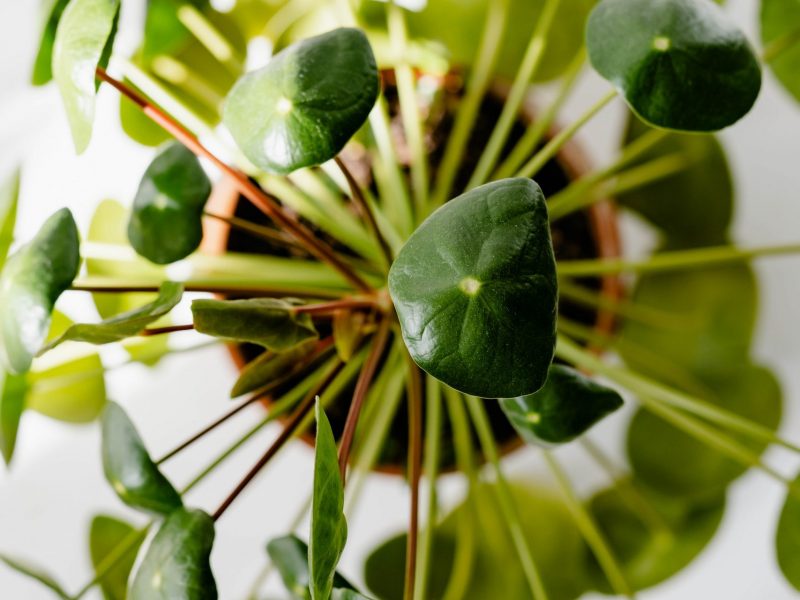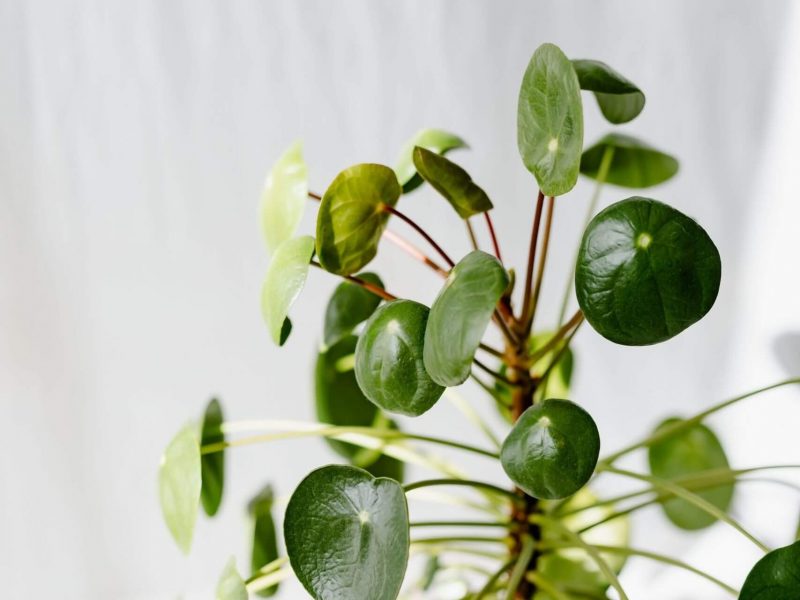
It’s always concerning to see that one of your houseplants isn’t thriving quite as much as you’d like it to be.
If you find that your Pilea leaves are curling inwards or cupping the likely causes are overwatering, pests or light/temperature stress. All of these conditions can be easily fixed — we just need to start off by figuring out what the root of the problem is for your Pilea.
The key reasons why Pilea leaves curl inwards
By looking at your Pilea and the environment that it’s in, you should find it easy to determine which of the following reasons are to blame for your Pilea’s leaves curling, wrinkling or cupping. Each of these issues is described in depth later in this post, with solutions to get your Pilea back into perfect shape.
Overwatering
Poor Drainage
Low Humidity Levels
Too much Light or Heat
Nutrient Deficiencies
Root Crowding
Complete Houseplant Care eBook
Our comprehensive (and rather good looking) eBook that will teach you everything you need to know to successfully care for, and maintain your houseplants!
Buy onOverwatering your Pilea
As with a lot of things in the houseplant world, proper watering can be one of the biggest issues. Overwatering is the key concern when it comes to Pilea, and it can be a major reason why leaves are starting to curl or wrinkle — which is odd as for most houseplants it’s normally the other way around.
We always go for a little and often view towards watering, but really it’s good to get to know what your plants like most as each and every one is ever so slightly different. We’d recommend picking up your Pilea when it needs watering and after you’ve watered it. This should give you a feel for when your Pilea might need a little more water in future, simply by giving it a lift. The best method to figure out how much moisture is in the potting mix is by using a moisture meter. You just pop them in the soil and it’ll tell you how damp or dry the soil is.
If you’d like to know more about proper houseplant watering, checkout our complete guide to watering.
Poor Drainage
A Pilea planted in a pot with poor drainage is bound to run into problems with curling, wrinkled or cupping leaves, just the same as one that is being overwatered. When a pot has poor drainage it can’t allow any of the excess liquid to escape, and so each time you water it the problem mounts up. This can ultimately result in root rot, a condition that is pretty difficult to escape from, though we have written a guide full of tips to avoid and resolve root rot if you think this could be a problem you’re facing.
You can very easily increase the amount of drainage in your Pilea soil by mixing in a small amount of perlite, this will make it far easier for water to flow through and out of the drainage holes of your pots (you should also check to make sure your pots have drainage holes). Another easy step is to add a few small stones or pebbles to the bottom of your pots, this helps in making sure that the drainage holes are never blocked by soil or any loose debris.
We also recommend using terracotta pots instead of plastic ones. These let some of the water escape from the sides of the pot, whereas plastic pots keep every drop of moisture in. These pots from Amazon are great!
By having proper drainage in the pot, you should hopefully start to notice your Pilea’s leaves curling less.
Low Humidity Levels
Pilea prefer a more humid environment, so if your home tends to have dry air it’s worth your time to try and increase the humidity a little as this may be causing your Pilea to have curling, wrinkling or cupping leaves. There are a few really simple techniques to keep the humidity higher than normal for your Pilea; you can spray down the leaves with a mist bottle every few days, or maybe sit your plant in a tray with water and some pebbles. The simplest way to increase the humidity for your Pilea is to buy a humidifier. They are really affordable gadgets which help to keep a nice constant humidity level for your plants. We recommend this one from Amazon.
You can always pick up a good humidity monitor to keep track of everything if you’re more concerned. Make sure to also move your Pilea away from any air conditioning units as these create very dry air, causing wrinkled leaves. If you’re interested in making sure you get the humidity just right, check out our full guide to humidity.
Light & Heat Stress
Your Pilea‘s leaves might also be curling due to the plant being in an area where it’s getting a little too much light, or it’s getting too hot. The perfect spot is just a touch further inside a bright room, potentially an east-facing window if there’s a good spot free.
If you’re not already, make sure to open your windows every now and then to make sure that the air in your room is circulating properly. This reduces the risk of hotspots forming in the room where your Pilea is sat. The ideal temperature for Pilea is between 18°C – 24°C, so it shouldn’t be too difficult to keep in a good range. You can always pick up a digital thermometer or a light meter to check the spot your Pilea is sat for peace of mind.
Nutrient Deficiency
Some leaf curling, wrinkling and cupping in a Pilea can be down to nutrient deficiencies. Make sure that you are correctly feeding (or fertilising) your Pilea year round so that they’re getting all of the key nutrients they need to continue thriving. Once a month feeds will be more than enough at half the strength that the bottle recommends. Our plants love this liquid fertiliser.
Root Crowding
With the possibility of causing multiple other issues, root crowding in your Pilea is worth checking every so often. Let your plant dry out for a couple of days after watering and then gently lift it from it’s pot, if all you can see are roots then it seems likely that overcrowding could be the source of your Pilea’s curling leaves. Grab a bigger pot, some more nutrient-rich soil (this potting mix from Miracle Gro is great) and gently dig through the roots with a chopstick to separate them out a little before repotting your plant with a little bit more room to grow.
If you find that when you take you Pilea from it’s pot that some of the roots have turned brown and soft then you could be in for the far bigger problem of root rot. In this case make sure to repot as soon as you can, removing as many of the infected (brown) roots as possible. You can read all about how to prevent, spot and fix root rot in our guide.
So overall we’ve found that there’s a wide range of reasons that your Pilea could be developing some curling, cupping or wrinkles in the leaves, but all of these problems can be easily solved with a little care and attention to how your Pilea is doing. Keeping up good habits and making sure that you know the warning signs should help in fending off leaf curling from happening to your Pilea again.














